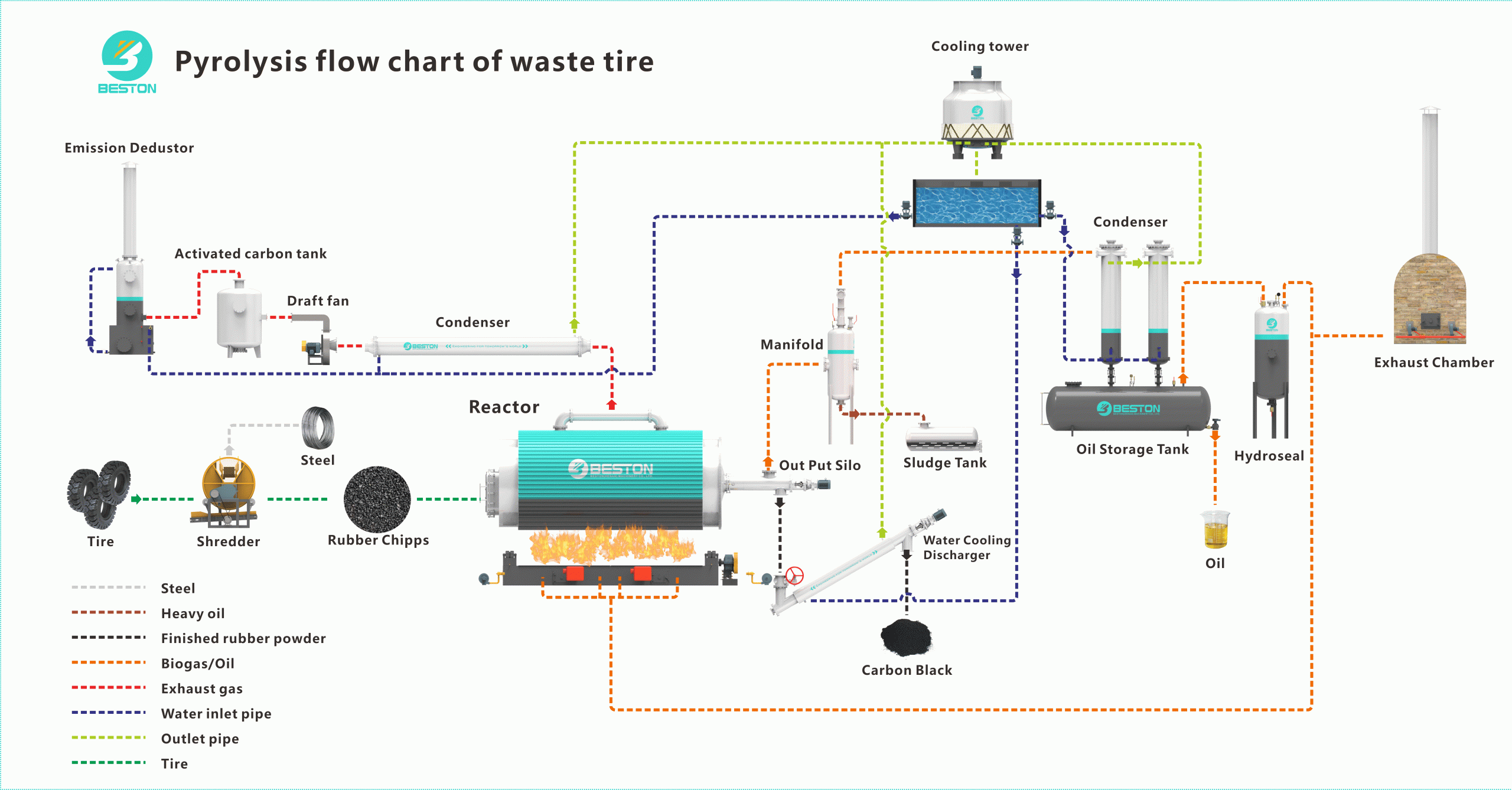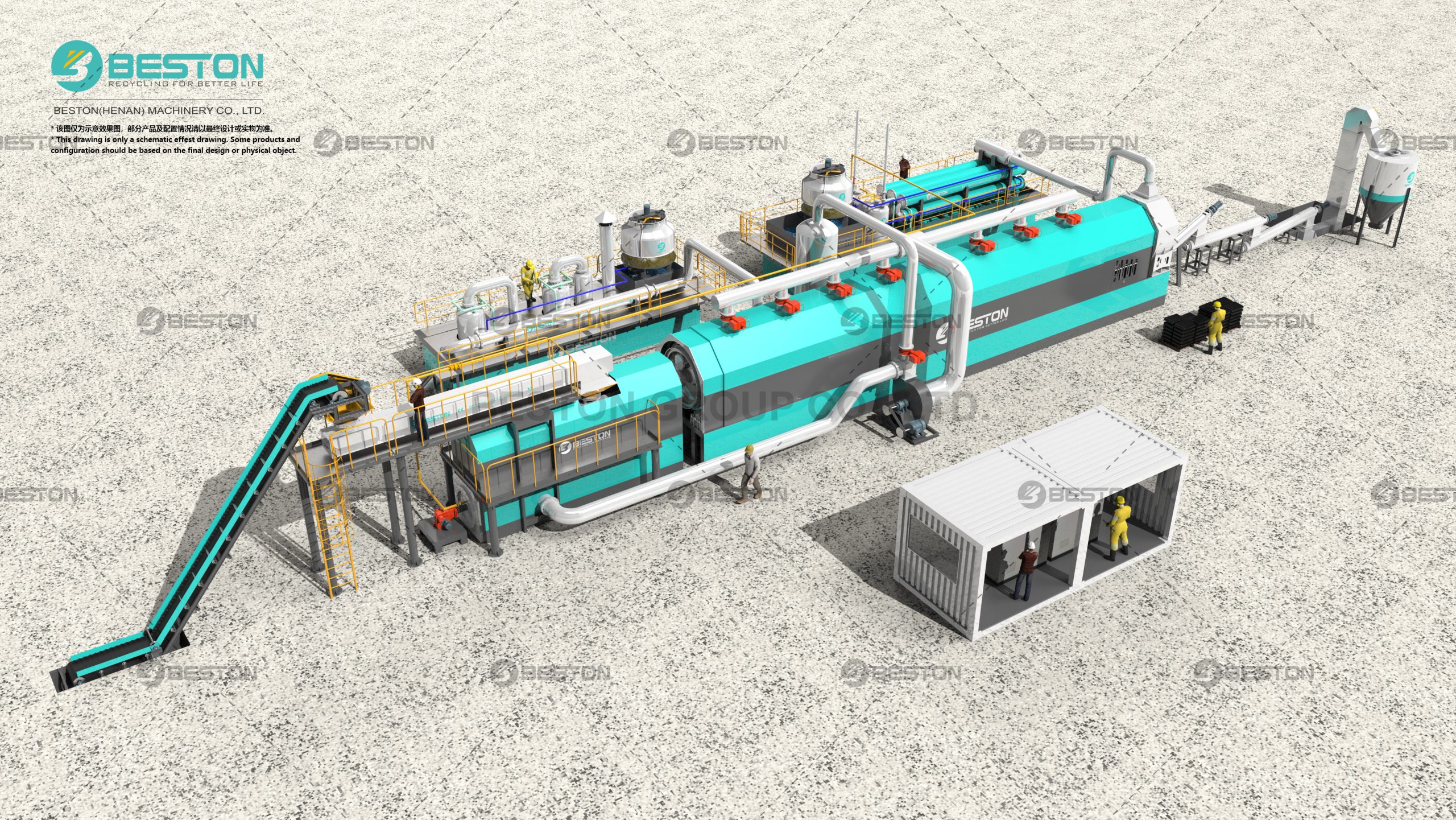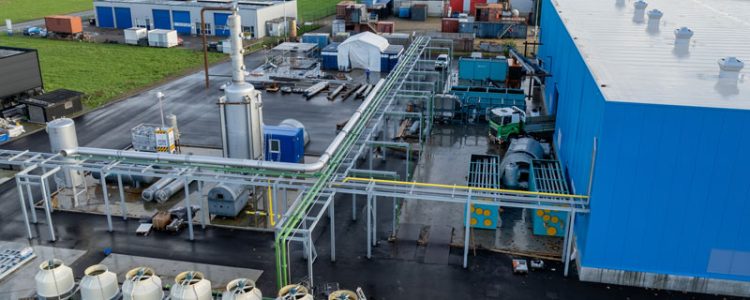In recent years, waste tyre pyrolysis plant has gained significant attention as a sustainable solution for waste management and resource recovery. These innovative plants utilize the principle of pyrolysis to transform waste tyres into valuable products such as fuel oil, carbon black, and combustible gas. In this article, we will explore the various aspects of waste tyre pyrolysis plants and delve into their advantages and environmental benefits.
How Waste Tyre Pyrolysis Plants Work
Waste tyre pyrolysis plant employs a well-defined process to convert waste tyres into useful resources. The following steps outline the functioning of these plants:
- Feedstock Preparation: Waste tyres are collected and undergo initial preprocessing, which may involve shredding or cutting them into smaller pieces. This prepares the feedstock for the pyrolysis process.
- Pyrolysis Reactor: The prepared waste tyres are then fed into the pyrolysis reactor, which is designed to withstand high temperatures and pressures. Inside the reactor, the thermal decomposition of the tyres occurs in the absence of oxygen, leading to the production of pyrolysis gas, oil, and carbon black.
- Heating and Pyrolysis: The pyrolysis reactor is heated using various heating methods, such as direct or indirect heating, to initiate and maintain the pyrolysis process. The temperature and duration of the process are carefully controlled to ensure optimal decomposition of the waste tyres and maximize the yield of valuable products.
- Condensation and Cooling: The gases produced during pyrolysis, including pyrolysis gas and vapors, are cooled and condensed using a condensation system. This transforms the gases into a liquid state, known as pyrolysis oil, which can be further processed for various applications.
- Gas Cleaning and Scrubbing: The gas generated during the pyrolysis process undergoes purification to remove impurities and contaminants. Gas cleaning systems, including filters and scrubbers, ensure that the produced gas meets the required quality standards, making it suitable for use as a fuel or in other industrial processes.
- Carbon Black Collection: Carbon black, a valuable by-product of waste tyre pyrolysis, is collected through a specialized system. This carbon black can be used in various industries, including rubber manufacturing, ink production, and construction materials.

Environmental Benefits of Waste Tyre Pyrolysis Plants
Significant environmental advantages also offered by the tyre to oil plant, contributing to sustainable waste management and resource conservation. Let’s explore some of these benefits:
- Emission Reduction and Air Quality: Traditional methods of waste tyre disposal, such as landfilling or incineration, can lead to the release of harmful pollutants into the atmosphere. Waste tire pyrolysis equipment, on the other hand, employs controlled processes that minimize emissions and promote cleaner air. By converting waste tyres into valuable resources, these plants help reduce the need for landfilling and incineration, leading to improved air quality and reduced environmental impact.
- Resource Recovery and Circular Economy: This plant enables the recovery of valuable resources from discarded tyres, promoting a circular economy approach. Instead of treating tyres as waste, these plants transform them into useful products such as fuel oil and carbon black. This reduces the demand for virgin resources and contributes to the conservation of natural resources.
- Waste Minimization and Landfill Diversion: Tyres are challenging to dispose of due to their durability and non-biodegradable nature. Waste tyre pyrolysis plants provide a sustainable solution by minimizing waste generation and diverting tyres from landfills. By converting tyres into valuable resources, these plants help reduce the environmental burden associated with tyre waste and land contamination.
- Energy Generation: The fuel oil produced through waste tyre pyrolysis can be used as a substitute for traditional fossil fuels. This offers an alternative energy source that can help reduce reliance on non-renewable resources and mitigate greenhouse gas emissions. The combustible gas generated during pyrolysis can also be utilized as a fuel for the plant’s heating system, further enhancing energy efficiency.
- Carbon Footprint Reduction: Tyre pyrolysis plants contribute to reducing the carbon footprint by diverting waste from landfills and promoting resource recovery. By converting waste tyres into valuable products, these plants help minimize the need for energy-intensive extraction and manufacturing processes, thus reducing greenhouse gas emissions associated with those activities.

Economic Viability and Considerations
While tyre pyrolysis machine offers significant environmental benefits, their economic viability is also crucial for successful implementation. Several factors influence the economic considerations of these plants:
- Feedstock Availability and Cost: The availability and cost of waste tyres in the region impact the economic feasibility of the pyrolysis plant. Access to a consistent supply of waste tyres at a tyre pyrolysis plant cost is essential for maintaining efficient operations and ensuring a positive return on investment.
- Product Demand and Market Dynamics: The market demand for the products derived from waste tyre pyrolysis, such as fuel oil and carbon black, plays a crucial role in determining the plant’s economic viability. Factors affecting product demand include global oil prices, industry requirements, and regional market dynamics. Understanding market trends and pricing considerations is essential for establishing a sustainable business model.
- Government Incentives and Support: Many governments provide incentives and support for waste management and renewable energy projects, including waste tyre pyrolysis plants. These incentives may include subsidies, tax benefits, grants, or preferential policies that enhance the financial feasibility of such projects. Researching and leveraging available government initiatives can optimize the economic viability of the plant.
- Maintenance and Safety Practices: Proper maintenance and adherence to safety protocols are paramount to ensuring the efficient and safe operation of the plant.
- Regular Inspection and Cleaning: Routine inspection and cleaning of the plant’s components maintain optimal performance. This includes checking for wear and tear, leakage, or blockages that may hinder the process. Cleaning procedures remove residual waste or contaminants from the system, ensuring smooth operation and minimizing the risk of equipment failure.
- Equipment Maintenance and Lubrication: Proper maintenance of equipment, such as pumps, valves, and reactors, prevents breakdowns and ensures longevity. Regular lubrication of moving parts, replacement of worn-out components, and calibration of instruments are part of an effective maintenance regime. Following manufacturer’s guidelines and scheduling periodic maintenance activities are essential for the safe and efficient operation of the plant.
- Operator Training and Safety Protocols: Thorough training of plant operators ensures their competence in handling the pyrolysis plant and following safety protocols. Operators should be knowledgeable about the plant’s operation, emergency procedures, and safety guidelines. Implementing robust safety protocols, including personal protective equipment (PPE), hazard identification, and incident response plans, mitigates potential risks and safeguards personnel.
Future Trends and Innovations in Waste Tyre Pyrolysis
The field of waste tyre pyrolysis continues to evolve, with ongoing research and development focused on enhancing efficiency and sustainability.
- Advanced Pyrolysis Technologies: Researchers are exploring advanced pyrolysis technologies, such as microwave pyrolysis and catalytic pyrolysis, to improve efficiency and product quality. These technologies aim to optimize process parameters, increase the yield of valuable products, and reduce energy consumption.
- Integration with Renewable Energy: This plant can be integrated with renewable energy sources, such as solar or wind power, to reduce reliance on traditional energy sources. This integration enhances the sustainability of the pyrolysis process and further reduces the carbon footprint.
- Product Diversification: Researchers are exploring innovative ways to utilize the products derived from waste tyre pyrolysis. This includes developing new applications for pyrolysis oil, carbon black, and combustible gas, expanding their market potential and creating additional revenue streams.
- Process Optimization and Automation: Continuous improvement in process optimization and automation plays a vital role in enhancing the efficiency and cost-effectiveness of waste tire pyrolysis equipment. Advanced monitoring systems, control algorithms, and automated process adjustments help streamline operations and improve overall plant performance.
If you want to know more about tire pyrolysis projects, welcome to visit our website: https://bestonasia.com/
Conclusion
Waste tyre pyrolysis plant is an innovative solution for addressing the challenges of waste tyre disposal while offering significant environmental and economic benefits. By converting waste tyres into valuable resources, these plants contribute to sustainable waste management, resource conservation, and the reduction of greenhouse gas emissions. As technology continues to advance, waste tyre pyrolysis is expected to play a pivotal role in the circular economy and the transition towards a more sustainable future.
